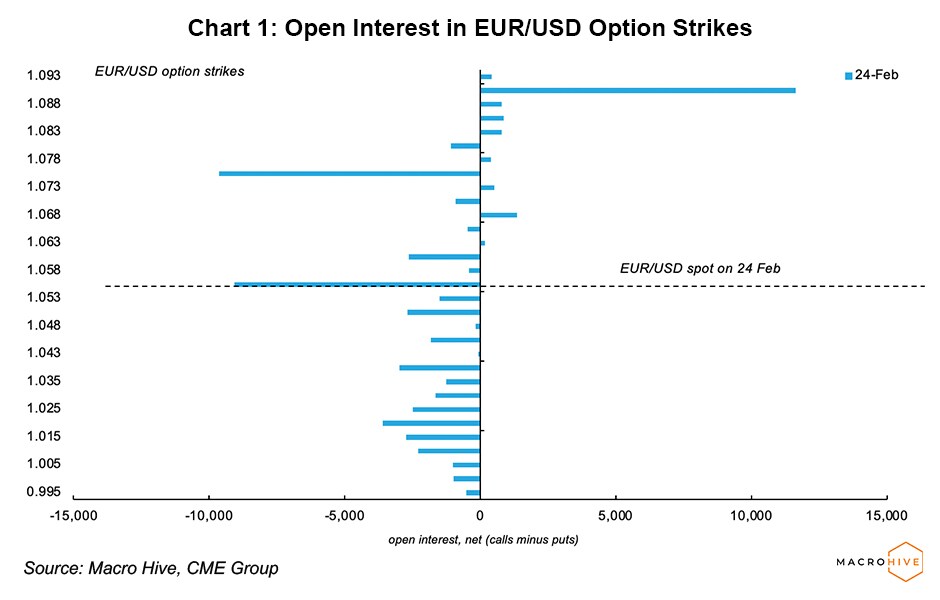CME Group FX Position Watch: USD Bulls in the Ascendancy
The opinions expressed in this report are those of Macro Hive and are considered market commentary. They are not intended to act as investment recommendations. Full disclaimers are available at the end of this report.
- The dollar has rebounded with a more hawkish Fed.
- CME Group data on option strikes suggest investors are bullish USD versus both EUR and JPY.
- The FX volatility curve using CME Group options data suggests investors remain in ‘fear’ mode.
At the start of the year, the US dollar began a downtrend. Over January, it fell 1.5% against the euro, 0.8% against the yen and a whopping 3.6% against the Australian dollar. But February has seen a sharp reversal. The dollar has surged against most currencies by 2.5% to 4.5%. EUR/USD is now down on the year, and USD/JPY is up on the year.
From a macro perspective, a dramatic re-appraisal of the Fed’s hiking path has been the trigger. The market was starting to price the end of the Fed hiking cycle, but strong payroll and inflation data has seen US yields jump higher. According to the CME FedWatch Tool, markets are now pricing an over 25% chance of the Fed raising rates by 50bps at their 22 March meeting. At the start of February, that probability was near zero.
FX investors have noticed. CME Group positioning data on FX options show net demand for USD calls versus both EUR and JPY at most strike levels. For EUR/USD, between 0.99 to 1.08, there is almost all net demand for EUR puts over EUR calls, with most demand for puts at around 1.055 and 1.075 (Chart 1). This reveals a bearish EUR and bullish USD bias for investors. For USD/JPY, we find a similar picture: consistent demand for USD/JPY calls over USD/JPY puts across most strikes from 139 to 146. The largest net demand for USD/JPY calls is at 137, 133 and 130 (Chart 2).
Macro Hive take: we are in the camp that the Fed will hike more than most investors think, which could sustain support for the dollar. But the coming weeks bring significant event risks that could change the dollar’s course. Ahead of the 22 March FOMC meeting, we will get payrolls (10 March) and CPI (14 March). Meanwhile, the ECB meets on 16 March, where the market is expecting a 50bp hike. And 10 March sees a BoJ meeting with risk of another YCC adjustment. Any of these events could easily reverse the dollar trend.
FX Investor Risk Appetite
CME Group has a range of FX volatility data to help investors track the level of volatility. We can also use FX volatility data to determine investor risk appetite. We find the shape of the FX volatility curve useful in this regard. When shorter-dated FX implied volatility is higher than longer-dated volatility, this suggests investors are worried or in panic mode. In contrast, when shorter-dated FX volatility is lower than longer-dated volatility, this suggests investors expect calm markets. The latest data finds:
- The FX volatility curve remains inverted but less so than before. Inversion means that shorter-term volatility is higher than longer-term volatility. So, it appears investors are still in ‘fear’ mode, but the picture could be improving (Chart 3).
- Another measure of nervousness is the CME Group CVOL volatility indices. The G5 aggregate FX index fell in January but has since gone sideways. It has tried to breach 10% but failed so far. Were it to succeed, this would signal heightened nervousness (Chart 4).
- Outside FX, both equity and rates volatility have jumped, suggesting more fear among investors.
- Overall, measures of volatility suggest investors are becoming more fearful.
Source: CME Group
Stay in the know
Get exclusive analysis from Macro Hive on the latest macro FX themes to watch and the FX futures and options to use to act.
The opinions and statements contained in the commentary on this page do not constitute an offer or a solicitation, or a recommendation to implement or liquidate an investment or to carry out any other transaction. It should not be used as a basis for any investment decision or other decision. Any investment decision should be based on appropriate professional advice specific to your needs. This content has been produced by Macro Hive. CME Group has not had any input into the content and neither CME Group nor its affiliates shall be responsible or liable for the same.
CME GROUP DOES NOT REPRESENT THAT ANY MATERIAL OR INFORMATION CONTAINED HEREIN IS APPROPRIATE FOR USE OR PERMITTED IN ANY JURISDICTION OR COUNTRY WHERE SUCH USE OR DISTRIBUTION WOULD BE CONTRARY TO ANY APPLICABLE LAW OR REGULATION.
